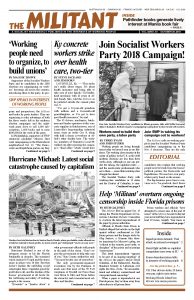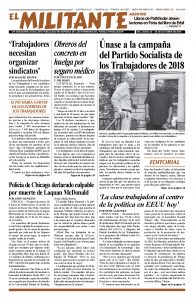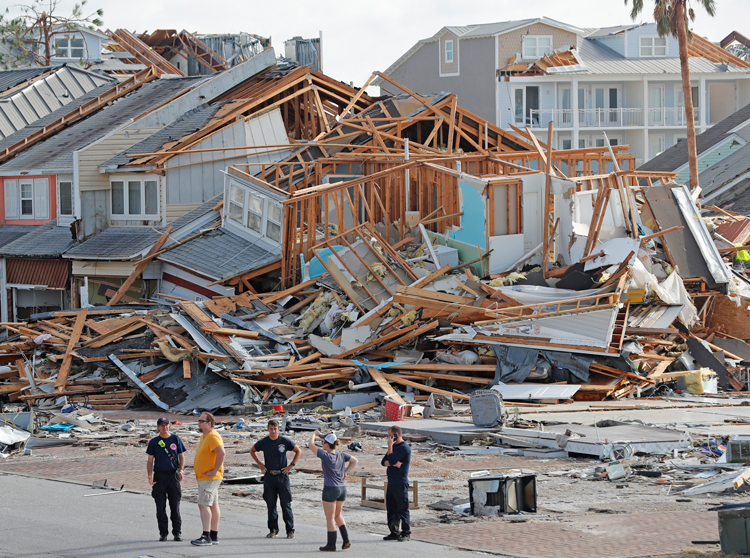Hurricane Michael is one of the strongest storms to hit the Florida Panhandle in decades. The sustained winds reached 155 mph and the storm surge in places was 10 feet. But that doesn’t explain the unfolding social catastrophe there. Capitalist greed for profit above all, and the disdain of the bosses’ government at all levels for the well-being and safety of working people is the reason.
“Evacuate” or “hunker down” is what government officials told people in the path of the storm. “Don’t expect the government to help take care of you,” Bay County authorities said. “You need to take care of yourselves.”
The only government-organized evacuation was by the Pentagon. It made sure that most of the 50 F-22 warplanes at Tyndall Air Force Base were flown to Ohio and Texas before the storm hit, and evacuated most soldiers and families.
Thousands of homes and buildings were destroyed by the storm, which made landfall near Mexico Beach Oct. 10. The storm knocked out power and cellphone service to hundreds of thousands of people at its height and flooded or closed more than 1,200 roads in several states, including Florida, Virginia, the Carolinas and Georgia. Fifty-three poultry houses in Georgia were destroyed and crops were damaged throughout the region.
There have been 29 deaths so far from the storm. As of Oct. 16, there were still more than 300,000 homes and businesses without electricity in Florida, and over 1,000 people missing.
The seeds of the current social crisis go back decades.
The Miami Herald reported that the rules on the Panhandle for storm shutters, shatterproof windows, fortified roofs and elevation standards to protect from high waters are lax to maintain “the affordability of homes and apartments.” That translates into construction companies and real estate moguls cutting corners to maximize their profits.
After Category 5 Hurricane Andrew devastated parts of Miami in 1992, a statewide code to boost storm resistance of residential and commercial construction was drawn up. But it took 10 years until it was passed into law, and only for Broward and Miami-Dade counties. Lots of flimsy, but profitable, housing went up during that time.
It wasn’t until 2007 that the state legislature imposed the rules for high-velocity wind zones in other parts of the state, but not all.
While three-quarters of the homes on a mile-long stretch of Mexico Beach were damaged, one home — built with reinforced concrete — was left standing relatively unscathed. It shows that housing can be built to withstand extremely high winds and flood waters.
Gov’t blames working people
Capitalist government officials blame working people for staying in the face of the coming storm. Florida officials say that 285 people in Mexico Beach refused to heed a mandatory evacuation order.
Many working people in the Panhandle — where workers’ wages are among the lowest in Florida — felt they had little choice. Much of the area is rural, with many dirt roads, and a large percentage of people live in mobile homes. In Mexico Beach a third of the population is 65 years or older.
“I don’t have a way of getting away from here,” Mary Frances Parrish, 72, from Lynn Haven, told the Associated Press. “My car’s under repair and there’s nowhere to go or the money to pay for a place.”
The New York Times reported one single mother decided to stay after her employer said that if she left, she wouldn’t be paid. A family that did evacuate told the Times they spent $750 on hotels, food and gas just in the first three days.
As Michael picked up strength, government officials announced evacuation zones that applied to some 375,000 people, but did nothing to help people leave. The entire state of Florida had only 18 shelters open with a capacity of 1,656 people.
Florida prison officials evacuated 2,600 prisoners from the Gulf Correctional Institution, along with hundreds more from three other prisons, after the hurricane caused major damage there. The Department of Corrections, despite pleas from family members, had refused to evacuate most prisons in the storm’s path ahead of time.
The government’s disregard for the lives of working people continues after the storm. Gas stations are running out of fuel. Cellphone towers remain down. Government and power company officials say that it may take months to restore electricity and drinking water.
‘No clue when help is coming’
The Weather Channel in its Oct. 15 lead news story on the disaster reported, “No power, no internet, no food and water and no clue when help is coming.”
Showing his scorn for working people, Federal Emergency Management Agency head William Long stated that “expectations that things will be put back together instantly is mistaken.” But FEMA was quick to add a “Hurricane Michael Rumor Control” page to its website. First on the list: “Rumor: The Federal Government Isn’t There And Is Leaving People To Fend For Themselves.”
But Florida officials lost no time in implementing police measures to protect area businesses, imposing a nighttime curfew that began the day of the storm and sending National Guard to protect stores from “looting.”
Global warming?
Much of the media coverage blames the strength of Hurricane Michael on “global warming.” Kim Cobb, director of the Global Change Program at Georgia Institute of Technology, wrote in the Oct.14 Washington Post that Hurricanes Michael, Katrina, Sandy, Harvey, Maria and Florence were “all supercharged by manmade climate change.”
But Cobb conveniently leaves out mention of previous Category 5 hurricanes, like the 1935 Labor Day Hurricane in the Florida Keys, Hurricane Camille along the Mississippi Gulf Coast in 1969 and Hurricane Andrew in 1992, because they don’t fit the global warming dogma.
Blaming global warming for the destruction diverts attention from the real cause of the catastrophe: the dog-eat-dog capitalist profit system and the actions — and lack of action — by the capitalist rulers’ government.
In the absence of government action, many working people have banded together to help each other out. The Washington Post found Brenna McAllister, a former combat medic in Afghanistan, working with other veterans, using chain saws to cut through fallen trees 12 miles outside of Panama City.
“We just got a convoy of veterans trained in working in war zones and went to work,” she said. “It gives us a sense of purpose.”
Alternative of revolutionary Cuba
There is an alternative — the way the revolutionary government in Cuba mobilizes workers and farmers there to prepare for threatening storms. How they use the state’s resources to organize needed evacuation of both people and pets to ensure everyone has shelter and food, and to organize workers and material to rebuild.
Michael hit western Cuba. The government organized a timely evacuation. They sent in five contingents of electrical workers that got most people’s power back on the day after the storm in hardest-hit Pinar del Río, sent roofing kits to repair the 120 roofs destroyed, and 15,000 fibrocement panels to repair holes. President Miguel Díaz-Canel led a government team to help organize the recovery.
“The province is not going to be alone in the recovery,” said First Vice President Salvador Valdés Mesa.


